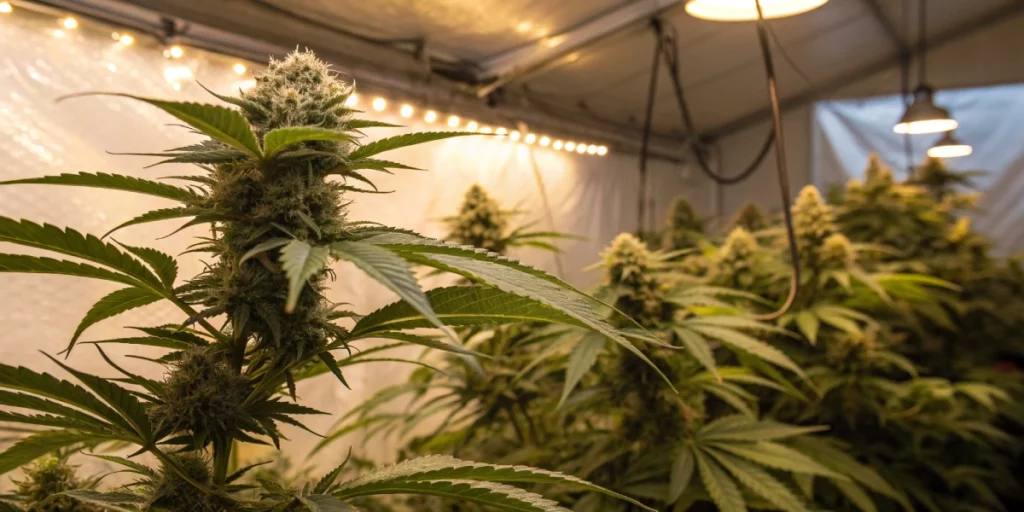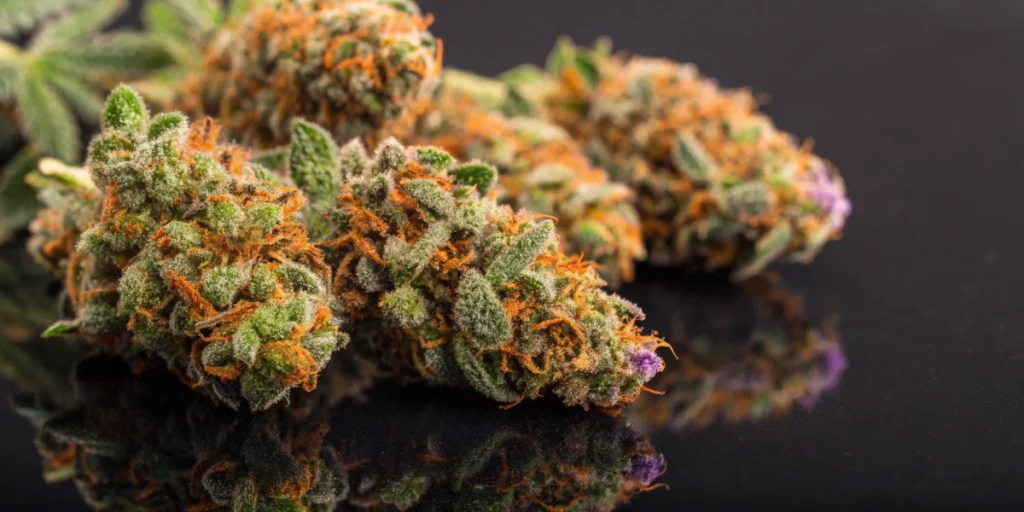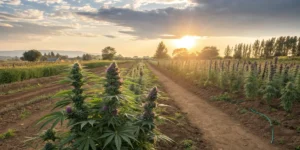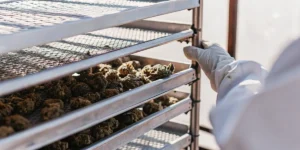Ever heard of a strain that smells like dessert, hits like a truck, and grows like a dream? If not, keep reading. There’s something about the Fat Banana strain that makes growers come back to it season after season. This strain delivers more than just flavor, it rewards attention to detail with generous yields, potent effects, and a growing cycle that suits both indoor and outdoor setups. Whether you’re new to cannabis or already have a few harvests under your belt, understanding how to cultivate Fat Banana strain properly can make all the difference in quality.
Fat Banana Strain: Exceptional Genetics and Effects
Origins and Genetics
Fat Banana strain was created by crossing Banana and OG Kush, resulting in a rich, fruity hybrid with strong indica traits. It delivers dense buds packed with flavor and potency. The breeders focused on enhancing both yield and terpene content, creating a plant that’s easy to manage yet highly productive. Its heritage is carefully stabilized to provide consistent structure and flowering time, making it predictable for both commercial and hobby growers.
This strain grows short and stocky with thick side branches, perfect for small grow spaces. Its genetics make it ideal for indoor setups, and it responds well to training methods like topping or LST. The fast-flowering structure comes from its indica roots, while the flavor profile and euphoria reflect its sativa influence. Growers can count on uniform growth and tightly packed nodes that support heavy buds later in the cycle.
Effects and Potency
Fat Banana strain typically reaches THC levels of 25%, producing a powerful body high that begins with a rush of happiness. The initial cerebral uplift quickly melts into physical calm, making it great for evening use. Users often note deep relaxation and a sense of calm without being couch-locked. It’s popular among those seeking stress relief or help falling asleep without overwhelming sedation.
The flavor is where this strain shines. It smells like overripe bananas, tropical fruits, and vanilla. The smoke is smooth and thick, with a lingering sweetness. Its heavy resin production makes it a top pick for hash or concentrates. It’s often chosen by those looking to unwind after a long day. Whether smoked or vaporized, its creamy taste and tropical aroma remain a standout.
Environmental Requirements for Growing Fat Banana Strain
Setting Up the Growing Cannabis Space
To grow Fat Banana strain successfully, start with a clean, ventilated space. Whether it’s a tent or a closet, good airflow is essential. Install an exhaust fan with a carbon filter to manage smell and humidity. Add intake vents and oscillating fans to promote air circulation around the canopy. A clean space also reduces the chances of mold, pests, and bacterial issues during late flowering.
Use reflective walls like Mylar to maximize light efficiency. Containers should hold at least 10 liters of soil or coco, and drainage must be optimal. This strain doesn’t like wet feet. Place your pots with enough space to allow side branching. As it matures, the plant will fill out quickly. Avoid overcrowding to ensure lower bud sites receive enough light and airflow.
Temperature and Humidity
Keep day temperatures between 22–26 °C and night temperatures around 18 °C. During vegetative growth, humidity can range from 55% to 65%, but during flowering drop it to 40%–45%. Stable climate helps Fat Banana strain avoid mold and develop dense, resin-coated buds. Invest in digital thermometers and hygrometers to keep levels accurate throughout each growth phase.

Indoor Cannabis Cultivation
Advantages of Growing Indoors
Growing Fat Banana strain indoors means you can control every aspect of its environment. This makes it easier to manage nutrients, light cycles, and pests. The short, bushy structure fits perfectly in tents and small rooms. Training techniques allow you to shape the plant and boost yields with minimal effort. You can also stagger plantings to create a perpetual harvest setup.
Indoor setups also give you multiple harvests a year. Fat Banana strain flowers in about 7 to 8 weeks, which means you can cycle quickly. The smell is strong, so a carbon filter is key. With good airflow, light, and nutrients, you’ll see consistent results each time. The predictable environment reduces stress on the plant, helping it reach its full potential.
Lighting Needs
Use full-spectrum LEDs or HPS lights. Provide 18 hours of light during veg and switch to 12/12 to flower. Keep lights 30–40 cm above the canopy and adjust as the plant grows. Consistent light exposure ensures fat, resinous buds that match the strain’s name. Supplemental UVB light during late flower may also boost resin production.
Outdoor Cannabis Cultivation
Best Conditions for Outdoor Growth
Fat Banana strain also performs well outdoors in sunny, warm climates. Choose a spot with full sun exposure and good wind flow. The plant grows wide and heavy, so consider using tomato cages or bamboo stakes for support. Avoid overly wet environments, as moisture can lead to mold. Outdoor growers should use mulch to retain moisture and protect the root zone from heat.
Start seeds after the last frost and harvest in late September to early October. In ideal outdoor conditions, the plant can yield large harvests. Regular pruning helps light reach inner buds and improves airflow. With rich organic soil and balanced nutrients, you’ll see vibrant colors and large colas. The natural sunlight also enhances terpene production for even better flavor.
Advantages of Growing Fat Banana Strain
One big advantage of Fat Banana strain is its yield. Indoors, you can expect up to 400 g/m², while outdoors plants may yield over 500 g each. Combine that with a fast flowering time and strong resistance to pests, and you have a reliable choice for any level grower. Its compact size and dense flower structure also make it a good fit for stealth or balcony grows.
Another plus is its aroma. Not many strains match its banana and citrus blend. It fills the room during flowering and carries over into the cured buds. If you’re into flavor and aroma, this one stands out. Its trichome production also makes it excellent for extractions. The consistency in smell, taste, and high make it a favorite across the board.
Problems in Cultivating Fat Banana Strain
Overwatering
Fat Banana strain doesn’t like soggy soil. Overwatering can lead to root rot and stunt growth. Let the top few centimeters of soil dry out before watering again. Ensure pots drain well and avoid letting them sit in runoff. Use moisture meters or lift pots to check water needs. A light, well-aerated mix helps reduce water retention issues.
Pest Infestations
Spider mites and aphids may target this strain, especially in warmer months. Keep humidity controlled and inspect plants often. Neem oil and insecticidal soap help prevent outbreaks. Use sticky traps and beneficial insects like ladybugs to keep pests under control without harming your crop. Regularly clean your space and tools to limit pest entry points.
Similar Strains
Gushers
Gushers delivers a fruity, sweet profile and relaxing effects similar to Fat Banana strain. It grows in a compact, dense structure with high trichome output. A great pick for fans of flavorful, resin-heavy strains.
Sundae Drivers
Sundae Drivers has a creamy, dessert-like aroma with uplifting and calming effects. Like Fat Banana strain, it thrives indoors and finishes in under nine weeks, rewarding growers with potent, aromatic yields.
Monkey Grease
Monkey Grease is a strong hybrid that shares the sticky trichome layers and rich aroma of Fat Banana strain. It grows wide and low, making it perfect for SCROG or small-space grows. Effects are heavy and long-lasting.
Week-by-Week Growth Plan for Fat Banana Strain
Week 1 – Germination and Seedling Stage
Soak seeds in water for 12 hours, then place between moist paper towels. Once taproots appear, move to small pots with light soil. Keep humidity around 70% and temperature near 22 °C. Use low-intensity light to avoid stress. Check daily for signs of healthy leaf development and ensure proper moisture.
Week 2 – Early Seedling Growth
Seedlings develop their first true leaves. Provide 18 hours of light and keep soil moist but not soaked. Avoid strong nutrients at this stage. Focus on root development and prevent damping off with good airflow. Monitor for even leaf coloration and early branching, checking daily for signs of deficiencies.
Week 3 – Continued Seedling Development
Plants now have several sets of leaves and start growing quickly. Gradually increase light intensity. Begin feeding a low dose of nitrogen-rich nutrients. Transplant to larger pots if roots are established. Start light LST to encourage outward growth and prepare for flowering. Look for signs of rapid development.
Week 4 – Vegetative Growth Begins
Fat Banana strain enters full veg mode. Increase feeding to half strength and maintain 18 hours of light. Begin serious training with topping or LST to shape canopy. Keep temps at 24 °C and humidity at 55%. Water only when top layer dries out. Plants will start showing thicker stems and more vigorous branching.
Week 5 – Accelerated Vegetative Growth
The plant grows fast, with large leaves and thicker stems. Increase airflow and defoliate inner leaves if needed. Feed at full strength and monitor pH around 6.3. Support branches as needed. Prepare for pre-flowering signs like pistils. Healthy plants will double in size this week.
Week 6 – Preparing for Flowering
Pistils emerge, signaling flowering ahead. Switch to bloom nutrients with more phosphorus and potassium. Change light cycle to 12/12. Reduce humidity to 45%. Keep canopy even to ensure light reaches all bud sites. Watch for early stretch and train as needed to control vertical growth.
Week 7 – Transition to Flowering
Fat Banana strain starts producing small buds. Keep feeding bloom nutrients. Watch for signs of overfeeding. Buds will begin to swell. Maintain consistent temperatures and airflow. Remove any yellowing leaves and keep pests at bay. Aromas will begin to build.
Week 8 – Early Flowering
Buds thicken and trichomes appear. Aroma intensifies. Keep humidity below 45% and increase potassium. Continue to monitor leaf health and adjust feeding as needed. Light stress can be used to increase trichome production, but keep it minimal. The plant begins to show its final shape.
Week 9 – Mid-Flowering
Buds are now dense and sticky. Trichomes shift from clear to cloudy. Begin flushing if harvest window is close. Maintain strong airflow and inspect for mold or pests daily. Consider staking branches to support weight of colas. The plant will smell very strong at this stage.
Week 10 – Bud Development
This is where weight packs on. Buds are aromatic and coated in resin. Trichomes may show amber if you prefer a more relaxing effect. Continue flushing with pure water. Keep lights steady and avoid environmental swings. Monitor for final ripening signs and fading of fan leaves.
Week 11 – Late Flowering
Harvest is near. Pistils darken and curl. Most trichomes are cloudy, with some amber. This is the peak potency point. Stop feeding and ensure soil dries out slightly before harvest. Prepare your drying space. Trimming can start immediately after chopping.
Week 12 – Harvesting Time
Cut the plant at base and hang branches upside down in a dark space with 50% humidity. After 7–10 days, when stems snap cleanly, begin trimming and jar curing. Cure for at least two weeks to maximize flavor and potency. Slow drying prevents chlorophyll retention and sharp taste.
Week 13–14 – Curing the Buds
Place buds in glass jars and burp daily during the first week. After day 10, reduce burping to every two days. Store in a cool, dark place. Curing brings out the banana and citrus notes and enhances smoothness. By the end of week 14, buds are ready to consume or store long-term.

FAQs about Fat Banana Strain
How long does Fat Banana strain take to flower?
Fat Banana strain usually flowers in 7 to 8 weeks indoors. Outdoors, it’s ready by late September or early October. Fast flowering means you can get quick harvests without waiting months. It’s one of the reasons many growers choose this variety again.
What does Fat Banana strain taste like?
It has a rich banana flavor with hints of tropical fruit and vanilla. The smoke is sweet and creamy, making it very pleasant on the throat. This flavor carries through from flowering to cure, especially when grown in optimal conditions.
Is Fat Banana strain hard to grow?
Not at all. It’s considered beginner-friendly due to its short height, strong resistance, and fast growth. Just avoid overwatering and provide plenty of light. Regular feeding and training techniques can really boost the yield and quality.





